Neolithic settlements, royal tombs with frescoed walls, gold caskets and gold wreaths and crowns, waterfalls, rivers, high mountains, verdant villages and endless plains are some of the things Imathia has to offer. Veria is the prefectural capital, a modern town that still has several traditional neighbourhoods. In Byzantine times it was a major center, one of the chief cities of Macedonia. Its past importance is reflected in its 51 Byzantine and post-Byzantine churches, many of which contain wonderful wall paintings.
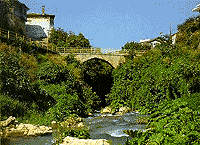 It is only 12 kilometers northwest of Vergina, which gained world-wide renown with the discoveries made by Professor Manolis Andronikos there in the late 1970s. The incredible wealth of the site’s finds led to the conclusion that Vergina was actually the first capital of the kingdom of Macedonia, Eges.
It is only 12 kilometers northwest of Vergina, which gained world-wide renown with the discoveries made by Professor Manolis Andronikos there in the late 1970s. The incredible wealth of the site’s finds led to the conclusion that Vergina was actually the first capital of the kingdom of Macedonia, Eges.
The excavations brought to light the acropolis, well-preserved sections of the walls, foundations of Hellenistic houses, the palace, theater, a temple and, to the north of the ancient city, the cemetery.
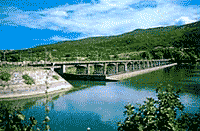 However, the most important monument at Vergina is the complex of royal tombs, which were unearthed in 1977-78 in the present-day village. The largest of them belonged to Philip II, a smaller one to a young prince, perhaps Alexander, and the third – square in shape – to a woman.
However, the most important monument at Vergina is the complex of royal tombs, which were unearthed in 1977-78 in the present-day village. The largest of them belonged to Philip II, a smaller one to a young prince, perhaps Alexander, and the third – square in shape – to a woman.
Many funerary steles were found in the vicinity, bearing invaluable inscriptions, all of them in Greek.
Philip’s grave yielded a marble sarcophagus in which a solid gold larnax had been placed containing the ashes of the dead man and his golden crown. Round the box lay weapons, various vases and utensils bearing the royal seal.
Here, too, was buried one of Philip’s seven wives. Her bones were also gathered in a gold larnax, in which there was another gold crown, one of the most beautiful pieces of ancient jewelry ever found, and a gold-weave purple cloth decorated with flowers and birds, which is on display along with the other funeral gifts in the Thessaloniki museum. However, something else, something utterly unique was also discovered in the grave: a painting of a hunting scene on an Ionian frieze. It is a masterpiece the like of which had only previously been seen in works of the Italian Renaissance.
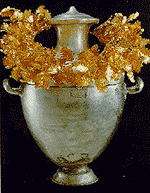 The Prince’s tomb is very similar to that of Philip. It, too, contains a painted frieze as well as a bed with gold and ivory ornamentation, surely one of the most elegant creations that has come down to us.
The Prince’s tomb is very similar to that of Philip. It, too, contains a painted frieze as well as a bed with gold and ivory ornamentation, surely one of the most elegant creations that has come down to us.
Finally, the cist tomb yielded a brilliant fresco depicting Pluto’s abduction of Persephone; this and the hunting scene are the only original works of any great painters of antiquity that have survived to the present.
Southwest of Veria, on the slopes of Vermion (18km.), lies the village of Kastanies, which is usually snowed-in during the winter. This is the site of the monastery of the Panagia Soumela, founded by refugees from the Pontos.
At Kato Vermio (26 km. from Veria), all that snow is put to good use at the Seli ski center (1.400 m. alt). A town noted for its waterfalls, its wine, its fruit and its Carnival customs is Naoussa. Siltuated 19 kilometers from Veria in a green, well-watered region, it is very picturesque with traditional houses and the Arapitsa River running through it. Near Naoussa is the village of Lefkadia, where Macedonian tombs and the remains of Hellenistic buildings have been found.
Finally, 9 km. northeast of Veria at Nea Nikomidia, excavations have revealed traces of a Neolithic settlement of the 7th millennium B. C., which is the oldest agricultural settlement along with Sesklo in Thessaly. The terra – cotta woman – shaped idols, as well as many frog figurines made of steatite are among the most interesting exhibits of the Veria Archaeological Museum.
 It is only 12 kilometers northwest of Vergina, which gained world-wide renown with the discoveries made by Professor Manolis Andronikos there in the late 1970s. The incredible wealth of the site’s finds led to the conclusion that Vergina was actually the first capital of the kingdom of Macedonia, Eges.
It is only 12 kilometers northwest of Vergina, which gained world-wide renown with the discoveries made by Professor Manolis Andronikos there in the late 1970s. The incredible wealth of the site’s finds led to the conclusion that Vergina was actually the first capital of the kingdom of Macedonia, Eges.The excavations brought to light the acropolis, well-preserved sections of the walls, foundations of Hellenistic houses, the palace, theater, a temple and, to the north of the ancient city, the cemetery.
 However, the most important monument at Vergina is the complex of royal tombs, which were unearthed in 1977-78 in the present-day village. The largest of them belonged to Philip II, a smaller one to a young prince, perhaps Alexander, and the third – square in shape – to a woman.
However, the most important monument at Vergina is the complex of royal tombs, which were unearthed in 1977-78 in the present-day village. The largest of them belonged to Philip II, a smaller one to a young prince, perhaps Alexander, and the third – square in shape – to a woman.Many funerary steles were found in the vicinity, bearing invaluable inscriptions, all of them in Greek.
Philip’s grave yielded a marble sarcophagus in which a solid gold larnax had been placed containing the ashes of the dead man and his golden crown. Round the box lay weapons, various vases and utensils bearing the royal seal.
Here, too, was buried one of Philip’s seven wives. Her bones were also gathered in a gold larnax, in which there was another gold crown, one of the most beautiful pieces of ancient jewelry ever found, and a gold-weave purple cloth decorated with flowers and birds, which is on display along with the other funeral gifts in the Thessaloniki museum. However, something else, something utterly unique was also discovered in the grave: a painting of a hunting scene on an Ionian frieze. It is a masterpiece the like of which had only previously been seen in works of the Italian Renaissance.
 The Prince’s tomb is very similar to that of Philip. It, too, contains a painted frieze as well as a bed with gold and ivory ornamentation, surely one of the most elegant creations that has come down to us.
The Prince’s tomb is very similar to that of Philip. It, too, contains a painted frieze as well as a bed with gold and ivory ornamentation, surely one of the most elegant creations that has come down to us.Finally, the cist tomb yielded a brilliant fresco depicting Pluto’s abduction of Persephone; this and the hunting scene are the only original works of any great painters of antiquity that have survived to the present.
Southwest of Veria, on the slopes of Vermion (18km.), lies the village of Kastanies, which is usually snowed-in during the winter. This is the site of the monastery of the Panagia Soumela, founded by refugees from the Pontos.
At Kato Vermio (26 km. from Veria), all that snow is put to good use at the Seli ski center (1.400 m. alt). A town noted for its waterfalls, its wine, its fruit and its Carnival customs is Naoussa. Siltuated 19 kilometers from Veria in a green, well-watered region, it is very picturesque with traditional houses and the Arapitsa River running through it. Near Naoussa is the village of Lefkadia, where Macedonian tombs and the remains of Hellenistic buildings have been found.
Finally, 9 km. northeast of Veria at Nea Nikomidia, excavations have revealed traces of a Neolithic settlement of the 7th millennium B. C., which is the oldest agricultural settlement along with Sesklo in Thessaly. The terra – cotta woman – shaped idols, as well as many frog figurines made of steatite are among the most interesting exhibits of the Veria Archaeological Museum.
Vergina
The ancient city lying on the north slopes of the Pierian mountains is securely identified as Aigai, the capital of the kingdom of Lower Macedonia. Archaeological evidence prooves that the site was continuously inhabited from the Early Bronze Age (3rd millenium B.C.) while in the Early Iron Age (11th-8th centuries B.C.) it became an important centre, rich and densely inhabited.
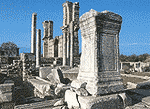 The city reached its highest point of prosperity in the Archaic (7th-6th centuries B.C.) and Classical periods (5th-4th centuries), when it was the most important urban centre of the area, the seat of the Macedonian kings and the place where all the traditional sanctuaries were established. Moreover, it was already famous in antiquity for the wealth of the royal tombs which were gathered in its extensive necropolis.
The city reached its highest point of prosperity in the Archaic (7th-6th centuries B.C.) and Classical periods (5th-4th centuries), when it was the most important urban centre of the area, the seat of the Macedonian kings and the place where all the traditional sanctuaries were established. Moreover, it was already famous in antiquity for the wealth of the royal tombs which were gathered in its extensive necropolis.
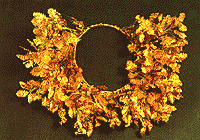 The first excavations on the site were carried out in the 19th century by the French archaeologist L. Heuzey and were resumed in the 1930's, after the liberation of Macedonia, by K. Rhomaios. After the Second World War, in the 1950's and 1960's, the excavations were directed by M. Andronicos, who investigated the cemetery of the tumuli. At the same time, the Palace was excavated by the University of Thessalonike and part of the necropolis by the Archaeological Service of the Ministry of Culture. In 1977, M. Andronicos brought to light the royal tombs in the Great Tumulus of Vergina (Megale Toumba). The most remarkable of these was the tomb of Philip II (359-336 B.C.) and its discovery is considered to be one of the most important archaeological events of the century. Since then, acontinuing excavations have revealed a series of significant monuments.
The first excavations on the site were carried out in the 19th century by the French archaeologist L. Heuzey and were resumed in the 1930's, after the liberation of Macedonia, by K. Rhomaios. After the Second World War, in the 1950's and 1960's, the excavations were directed by M. Andronicos, who investigated the cemetery of the tumuli. At the same time, the Palace was excavated by the University of Thessalonike and part of the necropolis by the Archaeological Service of the Ministry of Culture. In 1977, M. Andronicos brought to light the royal tombs in the Great Tumulus of Vergina (Megale Toumba). The most remarkable of these was the tomb of Philip II (359-336 B.C.) and its discovery is considered to be one of the most important archaeological events of the century. Since then, acontinuing excavations have revealed a series of significant monuments.
Immediately after the discovery of the royal tombs, in 1977, restoration work was begun for the exquisite wall paintings they included. A conservation laboratory was organized on the site in order to preserve and restore the priceless objects included in the tombs, such as couches made of ivory, gold and bone, metal vases etc.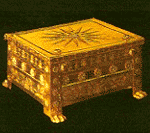 In 1993 was completed the subterranean structure that protects the tombs by retaining the stability of the temperature and humidity, which is necessary for the preservation of the wall paintings. As seen from outside, this building looks exactly like an ancient earthen tumulus.
In 1993 was completed the subterranean structure that protects the tombs by retaining the stability of the temperature and humidity, which is necessary for the preservation of the wall paintings. As seen from outside, this building looks exactly like an ancient earthen tumulus.
The Palace and the Theatre: These two important monuments are parts of the same complex, dated to the 4th century B.C. The palace is organized around a large, central peristyle court and comprises a circular shrine (Tholos) dedicated to Herakles Patroos, and luxurious banquet halls for the king and his officers. One of these rooms includes a fine mosaic floor.
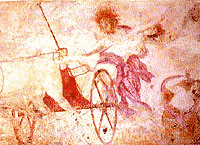 The temple of Eukleia: It lies to the north of the theatre and includes two temples of the 4th and 3rd centuries B.C., a monumental peristyle and a series of offerings among which two bases of the votive statues dedicated by queen Eurydice, grandmother of Alexander The Great.
The temple of Eukleia: It lies to the north of the theatre and includes two temples of the 4th and 3rd centuries B.C., a monumental peristyle and a series of offerings among which two bases of the votive statues dedicated by queen Eurydice, grandmother of Alexander The Great.
The acropolis and the city walls: It is located on a steep hill to the south of the settlement. The fortification wall extends to the east of the city. Excavations on the acropolis have revealed parts of the circuit wall and Hellenistic houses in the enclosed area. The fortification of Aigai dates to the early Hellenistic period (end of 4th-beginning of 3rd century B.C.).
The royal tombs to the NW of the city: Two Macedonian tombs are included in this group, the so-called "Rhomaios Tomb", an Ionic, temple-shaped structure, dated to the beginning of the 3rd century B.C. and the "Tomb of Eurydice", which probably belongs to the mother of Philip II and is dated to ca. 340 B.C. To the same group also belong three cist-graves dating from the 5th and 4th centuries B.C., as well as four pit-graves of the late Archaic period.
The tombs in the Bella tumulus: Three Macedonian tombs and one cist-grave dating from the Hellenistic period were found in the tumulus. One of the Macedonian tombs is decorated with an interesting wall painting and another contains an elegant marble funerary couch.
The cemetery of the tumuli: This is the imposing necropolis of the Iron Age (11th-8th centuries B.C.), which includes more than 300 small earthen tumuli, constructed over clusters of burials which contained rich offerings.
 The city reached its highest point of prosperity in the Archaic (7th-6th centuries B.C.) and Classical periods (5th-4th centuries), when it was the most important urban centre of the area, the seat of the Macedonian kings and the place where all the traditional sanctuaries were established. Moreover, it was already famous in antiquity for the wealth of the royal tombs which were gathered in its extensive necropolis.
The city reached its highest point of prosperity in the Archaic (7th-6th centuries B.C.) and Classical periods (5th-4th centuries), when it was the most important urban centre of the area, the seat of the Macedonian kings and the place where all the traditional sanctuaries were established. Moreover, it was already famous in antiquity for the wealth of the royal tombs which were gathered in its extensive necropolis. The first excavations on the site were carried out in the 19th century by the French archaeologist L. Heuzey and were resumed in the 1930's, after the liberation of Macedonia, by K. Rhomaios. After the Second World War, in the 1950's and 1960's, the excavations were directed by M. Andronicos, who investigated the cemetery of the tumuli. At the same time, the Palace was excavated by the University of Thessalonike and part of the necropolis by the Archaeological Service of the Ministry of Culture. In 1977, M. Andronicos brought to light the royal tombs in the Great Tumulus of Vergina (Megale Toumba). The most remarkable of these was the tomb of Philip II (359-336 B.C.) and its discovery is considered to be one of the most important archaeological events of the century. Since then, acontinuing excavations have revealed a series of significant monuments.
The first excavations on the site were carried out in the 19th century by the French archaeologist L. Heuzey and were resumed in the 1930's, after the liberation of Macedonia, by K. Rhomaios. After the Second World War, in the 1950's and 1960's, the excavations were directed by M. Andronicos, who investigated the cemetery of the tumuli. At the same time, the Palace was excavated by the University of Thessalonike and part of the necropolis by the Archaeological Service of the Ministry of Culture. In 1977, M. Andronicos brought to light the royal tombs in the Great Tumulus of Vergina (Megale Toumba). The most remarkable of these was the tomb of Philip II (359-336 B.C.) and its discovery is considered to be one of the most important archaeological events of the century. Since then, acontinuing excavations have revealed a series of significant monuments.Immediately after the discovery of the royal tombs, in 1977, restoration work was begun for the exquisite wall paintings they included. A conservation laboratory was organized on the site in order to preserve and restore the priceless objects included in the tombs, such as couches made of ivory, gold and bone, metal vases etc.
 In 1993 was completed the subterranean structure that protects the tombs by retaining the stability of the temperature and humidity, which is necessary for the preservation of the wall paintings. As seen from outside, this building looks exactly like an ancient earthen tumulus.
In 1993 was completed the subterranean structure that protects the tombs by retaining the stability of the temperature and humidity, which is necessary for the preservation of the wall paintings. As seen from outside, this building looks exactly like an ancient earthen tumulus. The most important monuments on the site are the following:
The royal tombs in the Great Tumulus: This group includes three Macedonian tombs and one cist-grave. One of them was the tomb of king Philip II and another probably belonged to king Alexander IV. These two graves were found unplundered and are lavishly decorated with splendid wall paintings, made by great and famous artists.The Palace and the Theatre: These two important monuments are parts of the same complex, dated to the 4th century B.C. The palace is organized around a large, central peristyle court and comprises a circular shrine (Tholos) dedicated to Herakles Patroos, and luxurious banquet halls for the king and his officers. One of these rooms includes a fine mosaic floor.
 The temple of Eukleia: It lies to the north of the theatre and includes two temples of the 4th and 3rd centuries B.C., a monumental peristyle and a series of offerings among which two bases of the votive statues dedicated by queen Eurydice, grandmother of Alexander The Great.
The temple of Eukleia: It lies to the north of the theatre and includes two temples of the 4th and 3rd centuries B.C., a monumental peristyle and a series of offerings among which two bases of the votive statues dedicated by queen Eurydice, grandmother of Alexander The Great.The acropolis and the city walls: It is located on a steep hill to the south of the settlement. The fortification wall extends to the east of the city. Excavations on the acropolis have revealed parts of the circuit wall and Hellenistic houses in the enclosed area. The fortification of Aigai dates to the early Hellenistic period (end of 4th-beginning of 3rd century B.C.).
The royal tombs to the NW of the city: Two Macedonian tombs are included in this group, the so-called "Rhomaios Tomb", an Ionic, temple-shaped structure, dated to the beginning of the 3rd century B.C. and the "Tomb of Eurydice", which probably belongs to the mother of Philip II and is dated to ca. 340 B.C. To the same group also belong three cist-graves dating from the 5th and 4th centuries B.C., as well as four pit-graves of the late Archaic period.
The tombs in the Bella tumulus: Three Macedonian tombs and one cist-grave dating from the Hellenistic period were found in the tumulus. One of the Macedonian tombs is decorated with an interesting wall painting and another contains an elegant marble funerary couch.
The cemetery of the tumuli: This is the imposing necropolis of the Iron Age (11th-8th centuries B.C.), which includes more than 300 small earthen tumuli, constructed over clusters of burials which contained rich offerings.
Veria
As with many of the greek cities there are various myths about the origin of the name Veria (mainly because our ancient Greeks did not like gap in their history.  The most popular mythological explanation is the one suggesting that the name comes from that of the nymph Veroi, the daughter of Ocean and Thetis, who after being born in the sea kingdom of her parents started wandering around and was so enchanted from our region that chose it as her abode and gave it her name.
The most popular mythological explanation is the one suggesting that the name comes from that of the nymph Veroi, the daughter of Ocean and Thetis, who after being born in the sea kingdom of her parents started wandering around and was so enchanted from our region that chose it as her abode and gave it her name.
Geographical location: With a population of approximately 50,000 and with a vivid activity in many fields, Veria is one of the most important towns of Central Macedonia. Built on the eastern slopes of mount Vermio, at an altitude of 50 m, it is located 72 km west of Thessaloniki. From here it is very easy to visit the marvelous royal tombs of Vergina, where Philip II, the father of Alexander the Great, is buried or the Macedonian tombs of Lefkadia and the school where Aristoteles taught. Also within easy reach of the town are the ski resorts of Seli and Tria-Pente Pigadia.
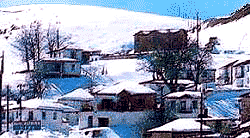 Economy: The economy of Veria is mainly based on agriculture and trading. The fertile grounds of the region produce a variety of fruits and vegetables which are exported all around the world. Veria is also a very active export center, the main exported goods being fresh and preserved agricultural products, threads and cotton. Many of the goods exported through Veria come from other regions of Greece.
Economy: The economy of Veria is mainly based on agriculture and trading. The fertile grounds of the region produce a variety of fruits and vegetables which are exported all around the world. Veria is also a very active export center, the main exported goods being fresh and preserved agricultural products, threads and cotton. Many of the goods exported through Veria come from other regions of Greece.
History: The traces of Veria are lost deep in time. The exact date of its founding is not yet known but American archaelogists have excavated the earliest European farming settlement, dating to the 6th or 7th millenium B.C., just a few kilometres outside the town; therefore making it safe to assume that it could in fact be one of the oldest towns on Earth! The oldest verified reference to Veria is the first book of Thucydides' History where it is mentioned that the Atheneans, while on an expedition against Halkidiki, tried to conquer the town (without success). Throughout the 2,500 years of its history it has been one of the main commercial, cultural and administrative centres of Macedonia.
Churches: There are 48 Byzantine and post-Byzantine churches in Veria, 40 of them with extensive frescoes. Some of the churches date back to the 11th century, making Veria an important centre of Byzantine ecclesiastic architecture.
Traditional architecture: Apart from the wonderful churches one can also look forward to seeing examples of traditional Greek architecture. Since the modern town of Veria evolved over and around the centre of the old town, many parts of the old town have been destroyed. The ones that survived almost intact until today are the Jewish quarters, the Kyriotissa area and the residences of Kontogeorgaki st. All these are protected under law and every effort is being made for them to be restored and put into active use.The restoration and restructuring of the historic centre of Veria is one of the main concerns of the Municipality of Veria.
 The most popular mythological explanation is the one suggesting that the name comes from that of the nymph Veroi, the daughter of Ocean and Thetis, who after being born in the sea kingdom of her parents started wandering around and was so enchanted from our region that chose it as her abode and gave it her name.
The most popular mythological explanation is the one suggesting that the name comes from that of the nymph Veroi, the daughter of Ocean and Thetis, who after being born in the sea kingdom of her parents started wandering around and was so enchanted from our region that chose it as her abode and gave it her name.Geographical location: With a population of approximately 50,000 and with a vivid activity in many fields, Veria is one of the most important towns of Central Macedonia. Built on the eastern slopes of mount Vermio, at an altitude of 50 m, it is located 72 km west of Thessaloniki. From here it is very easy to visit the marvelous royal tombs of Vergina, where Philip II, the father of Alexander the Great, is buried or the Macedonian tombs of Lefkadia and the school where Aristoteles taught. Also within easy reach of the town are the ski resorts of Seli and Tria-Pente Pigadia.
 Economy: The economy of Veria is mainly based on agriculture and trading. The fertile grounds of the region produce a variety of fruits and vegetables which are exported all around the world. Veria is also a very active export center, the main exported goods being fresh and preserved agricultural products, threads and cotton. Many of the goods exported through Veria come from other regions of Greece.
Economy: The economy of Veria is mainly based on agriculture and trading. The fertile grounds of the region produce a variety of fruits and vegetables which are exported all around the world. Veria is also a very active export center, the main exported goods being fresh and preserved agricultural products, threads and cotton. Many of the goods exported through Veria come from other regions of Greece.History: The traces of Veria are lost deep in time. The exact date of its founding is not yet known but American archaelogists have excavated the earliest European farming settlement, dating to the 6th or 7th millenium B.C., just a few kilometres outside the town; therefore making it safe to assume that it could in fact be one of the oldest towns on Earth! The oldest verified reference to Veria is the first book of Thucydides' History where it is mentioned that the Atheneans, while on an expedition against Halkidiki, tried to conquer the town (without success). Throughout the 2,500 years of its history it has been one of the main commercial, cultural and administrative centres of Macedonia.
Churches: There are 48 Byzantine and post-Byzantine churches in Veria, 40 of them with extensive frescoes. Some of the churches date back to the 11th century, making Veria an important centre of Byzantine ecclesiastic architecture.
Traditional architecture: Apart from the wonderful churches one can also look forward to seeing examples of traditional Greek architecture. Since the modern town of Veria evolved over and around the centre of the old town, many parts of the old town have been destroyed. The ones that survived almost intact until today are the Jewish quarters, the Kyriotissa area and the residences of Kontogeorgaki st. All these are protected under law and every effort is being made for them to be restored and put into active use.The restoration and restructuring of the historic centre of Veria is one of the main concerns of the Municipality of Veria.

